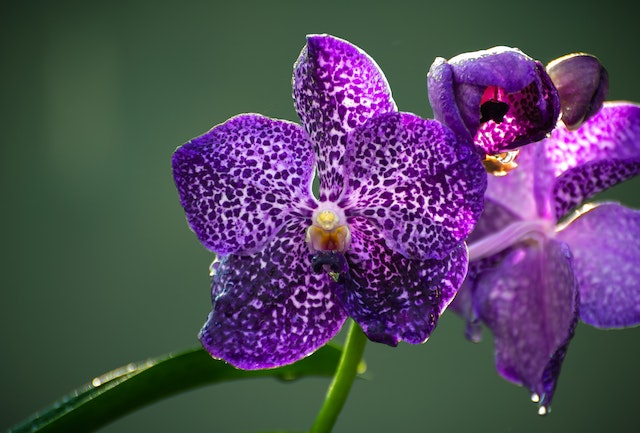Vanda orchids smell nice and are best known for having blue flowers, but they also have flowers of many other colors. The petals of the flowers are flat, but what makes them different from other orchids with similar-looking flowers is that they have long roots that wrap around trees and other things. The best time to plant these orchids is in early spring when they are coming out of their winter sleep. If the conditions are right, they will grow pretty quickly.
What Is a Vanda Orchid?
A vanda orchid is a type of orchid that belongs to the genus Vanda. These orchids are also known as strap-leaved or semi-terete vandas. Vandas are a type of monopodial orchid, meaning that they have a single main stem (monopodial) and their root system consists of one main root (monopodial). Around 80 species of vanda orchids are known to exist.
Vanda orchids come in a variety of colors, including white, yellow, pink, red, and purple. They typically bloom in the summer and their flowers can last up to two months. Vanda orchids prefer partial shade and need to be watered regularly.
How Much Humidity Do Vanda Orchids Need?
Vandas, like most orchids, require high humidity. They should be watered regularly, as they like to dry out between waterings. However, they do not tolerate wet feet and will rot if their roots are sitting in water. Vandas require at least 50% humidity and prefer to be misted several times a day.
How Do You Know if Your Orchid Is Dead?
To tell if your orchid is dead, inspect the pot and flower. If the pot is dry and the flower is wilted, your orchid is most likely dead. Another way to tell if your orchid is dead is to check the roots. If the roots are black and mushy, they are probably dead.
Why Choose a Vanda Orchid?
Vanda orchids are some of the most popular orchids in the world. They are prized for their beautiful flowers, which come in a wide range of colors. Vanda orchids are also very easy to care for, and they make excellent houseplants. If you’re looking for an orchid that is sure to please, a vanda orchid is a great choice.
How To Water & Fertilize A Vanda Orchid For Maximum Blooming Potential?
To water and fertilize a vanda orchid for maximum blooming potential, it is important to understand the plant’s needs. Vanda orchids need to be watered regularly, but they also like to dry out between waterings. This plant also needs to be fertilized regularly with a balanced fertilizer. When fertilizing, be sure to follow the directions on the fertilizer package. Too much fertilizer can harm the plant.
Vanda Orchids Care Tips
Some of the most beautiful and popular orchids are the vandas. Vanda orchids are available in a wide range of colors, and they make stunning houseplants. If you’re thinking about adding a vanda orchid to your collection, here are a few care tips to keep in mind.
Vandas prefer to be grown in pots rather than baskets. If you do choose to grow your vanda in a basket, make sure that it is well-ventilated and that the roots have plenty of room to spread out.
Vandas should be repotted every one to two years, using a pot that is only slightly larger than the previous one. When repotting, be careful not to damage the roots.
Water your vanda orchid regularly, but allow the potting mix to dry out between waterings. Vandas prefer high humidity, so misting the leaves occasionally will help to keep them healthy and happy.
How to Fertilize Vanda Orchids
To fertilize Vanda orchids, you will need to purchase a fertilizer that is specifically designed for orchids. Once you have the fertilizer, mix it according to the manufacturer’s instructions and then water your orchids with it. Be sure to fertilize your orchids every two weeks during the growing season and once a month during the winter.
How to Water Vanda Orchids
1. Fill a clean sink or bucket with lukewarm water.
2. Immerse the entire pot of your Vanda Orchid in the water. Allow the plant to soak for 5-10 minutes.
3. Carefully remove the pot from the water and allow any excess water to drain away.
4. Place your Vanda Orchid in a location where it will receive bright, indirect light and good airflow.
5. Water your Vanda Orchid every 7-10 days, or when the top inch of soil feels dry to the touch.
How to Get Vanda Orchids to Bloom
To encourage your Vanda orchid to bloom, start by giving it plenty of bright light. These tropical plants need at least 12 hours of sunlight each day to produce flowers. If you can, place your orchid near a south-facing window. If you’re growing your Vanda indoors, supplement with grow lights.
In addition to bright light, Vanda orchids need good air circulation to bloom. Be sure to keep your plant in a well-ventilated area. You may also want to consider mounting your orchid on a stake or trellis to help promote airflow around the plant.
Finally, keep your Vanda orchid evenly watered. These plants like their soil to be moist, but not soggy. Allow the top inch of soil to dry out between waterings. If your Vanda doesn’t bloom after following these tips, it may be time to repot the plant in fresh potting mix.
Common Problems With Vanda Orchids and How to Fix Them
The most common problems with Vanda orchids are brown leaves, yellow leaves, and a lack of flowers.
To fix these problems, you should first check the roots to make sure they are not rotting. If the roots are healthy, then you can try fertilizing the plant with a high-phosphorus fertilizer. If the leaves are still brown or yellow after fertilizing, then you may need to repot the plant in a pot that is one size larger.

